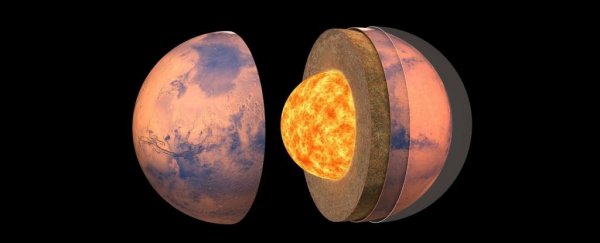An immobile probe sitting like a squat turtle on the surface of Mars has finally delivered a comprehensive picture of the red planet's internal structure.
The Mars InSight lander measured around 733 marsquakes, and used information on 35 of them, to form a picture of the crust, mantle, and core. It's the first time seismic data have been used to probe the interior of a planet other than Earth, and a major step towards understanding the evolution of rocky planets in the Solar System.
These marsquakes have revealed the thickness and structure of the crust and mantle, and a surprisingly large, low-density liquid core. The results have been described in three papers published in Science; they represent an absolutely stunning feat of scientific ingenuity and hard work.
"This study is a once-in-a-lifetime chance," said planetary seismologist Simon Stähler of ETH Zurich in Switzerland.
"It took scientists hundreds of years to measure Earth's core; after the Apollo missions, it took them 40 years to measure the Moon's core. InSight took just two years to measure Mars's core."
Quakes are quite marvelous things, really. They ripple out from their point of origin, propagating through the planet or moon or star, and bouncing around. The way these seismic waves propagate through and reflect off certain materials allows seismologists to map the interiors of the host objects.
Up until relatively recently, Mars wasn't thought to be particularly geologically active. It doesn't have tectonic plates, but one discrete crustal layer. Although there are ancient volcanic regions, new volcanic activity hadn't been observed. It also doesn't have a global magnetic field, which on Earth is generated by a dynamo - an internal rotating, convecting, and electrically conducting fluid (the core) that converts kinetic energy into magnetic energy, spinning the magnetic field out into space.
However, recent observations have suggested that the red planet isn't as dead as we thought. There have been hints of volcanic activity. And, in April of 2019, InSight detected its very first rumbles from the interior of Mars - finally, direct evidence of marsquakes.
Since then, over 700 marsquakes have been cataloged - around 35 of which were strong enough for seismic mapping, even working with the limitations of InSight: Here on Earth, seismic mapping is conducted using multiple monitoring stations. InSight is just a single probe.
"The direct seismic waves from an earthquake are a bit like the sound of our voices in the mountains: they produce echoes," explained planetary seismologist Philippe Lognonné of the University of Paris in France.
"And it was these echoes, reflected off the core, or at the crust-mantle interface or even the surface of Mars, that we looked for in the signals, thanks to their similarity to the direct waves."
Starting from the outside in, the first paper characterizes the thickness of the Martian crust, based on the thickness of the crust at the InSight site. They found that, on average, the crust is somewhere between 24 and 72 kilometers (15 to 45 miles) thick, and consists of at least two layers.
The uppermost layer is unexpectedly porous, the researchers found, and the crust at the landing site unexpectedly thin. This suggests a high proportion of radioactive elements in the crust, which means we may have misunderstood the composition of the crust in previous models.
"What seismology can measure are mainly velocity contrasts. These are differences in the propagation velocity of seismic waves in different materials," said Brigitte Knapmeyer-Endrun of the University of Cologne in Germany.
"Very similar to optics, we can observe phenomena like reflection and refraction. Regarding the crust, we also benefit from the fact that crust and mantle are made of different rocks, with a strong velocity jump between them."
The next paper probed the mantle, and found that it consists of a single layer of rock, with the solid lithosphere extending between 400 and 600 kilometers. This is in contrast to Earth's lithosphere, which is about 100 kilometers thick; however, both lithospheres likely have a lower region where material starts to get a bit molten, and moves slowly.
Like the crust, Mars's mantle is also likely enriched with radioactive elements.
"Seismic data has confirmed that Mars presumably was once completely molten before dividing into the crust, mantle and core we see today, but that these are different from Earth's," said geophysicist Amir Khan of ETH Zurich.
"The thick lithosphere fits well with the model of Mars as a 'one-plate planet'."
Finally, the third paper probed the Martian core and its boundary. Firstly, the researchers found that Mars's mantle likely has only one layer, in contrast to Earth's two mantle layers.
Secondly, the core is much larger than we previously thought, with a radius of about 1,830 kilometers. That's huge - over half the planetary radius of 3,390 kilometers, and 200 kilometers bigger than thought.
The seismic data also suggest that the core is liquid, although the larger size indicates it has a lower density than previously thought. This means that the core likely has lighter elements such as sulphur, oxygen, carbon and hydrogen in addition to iron and nickel, which has implications for the mineralogy of the core-mantle boundary.
This information could help us figure out how Mars lost its dynamo, and associated magnetic field - information that could, in turn, help us better understand planetary dynamos and magnetic fields in general, and those of Earth in particular.
"The InSight mission was a unique opportunity to capture this data," said seismologist and geoscientist Domenico Giardini of ETH Zurich.
"But we're far from finished analysing all the data - Mars still presents us with many mysteries, most notably whether it formed at the same time and from the same material as our Earth."
The three papers have been published in Science. They can be found here, here and here.
